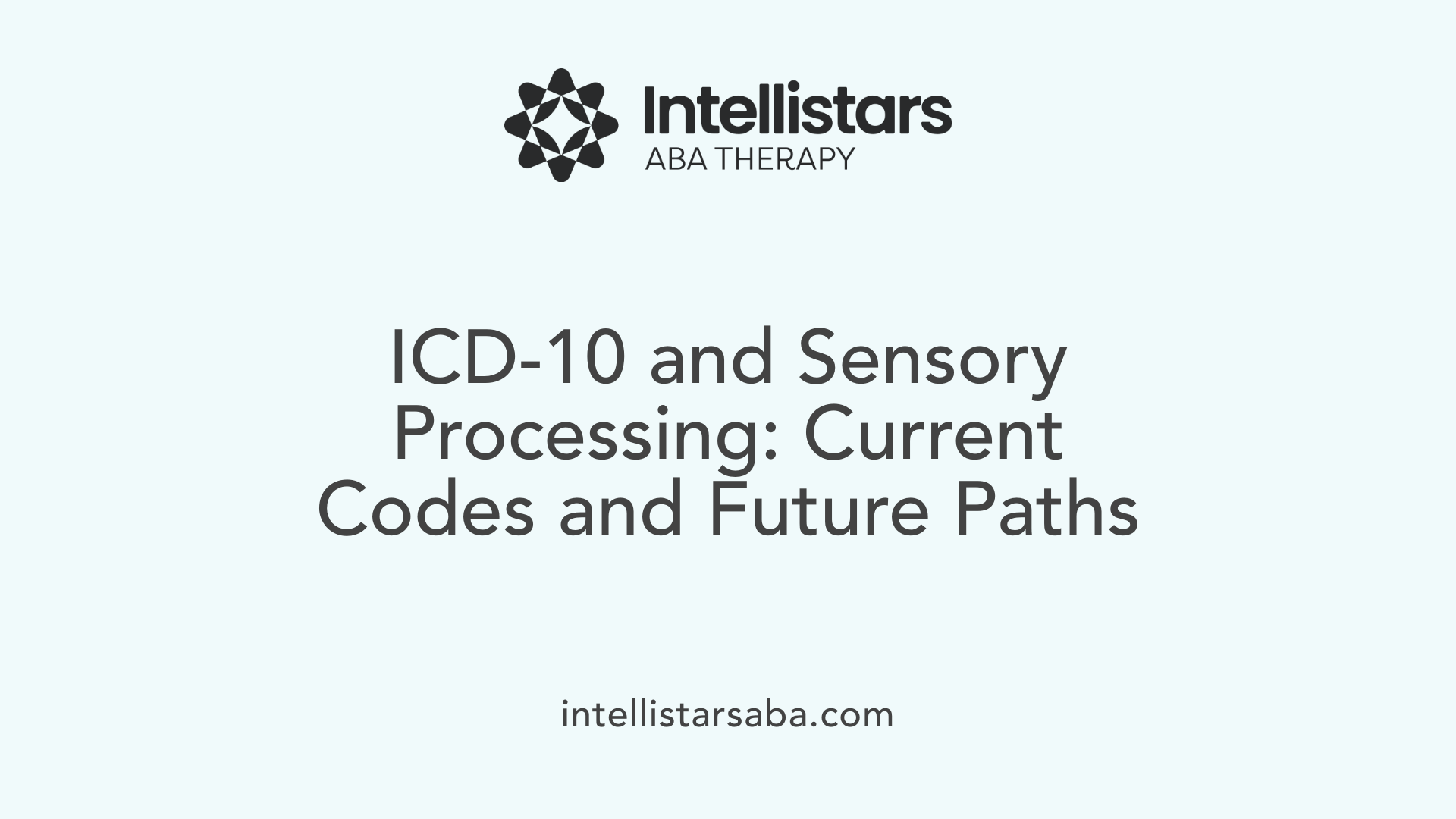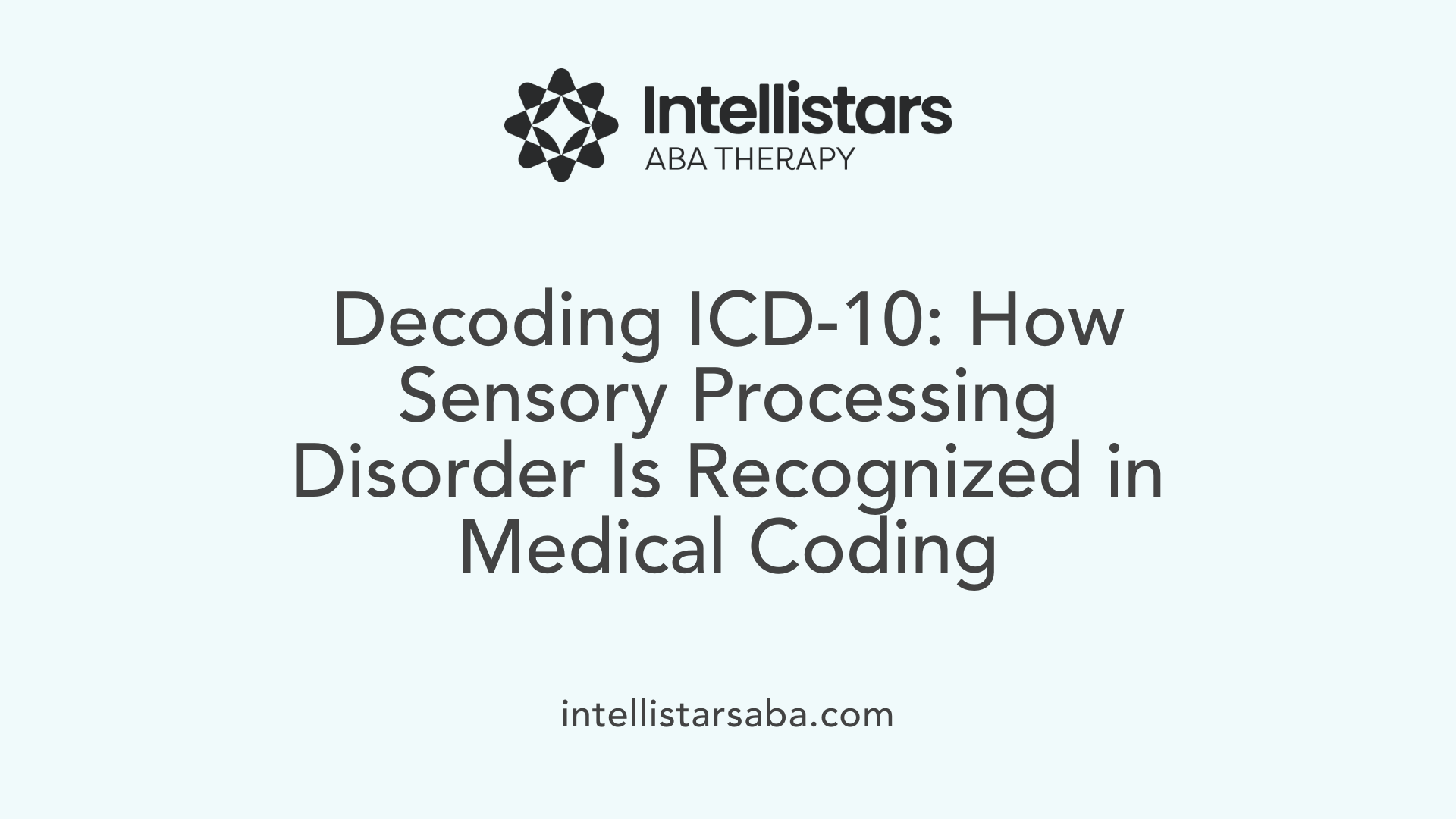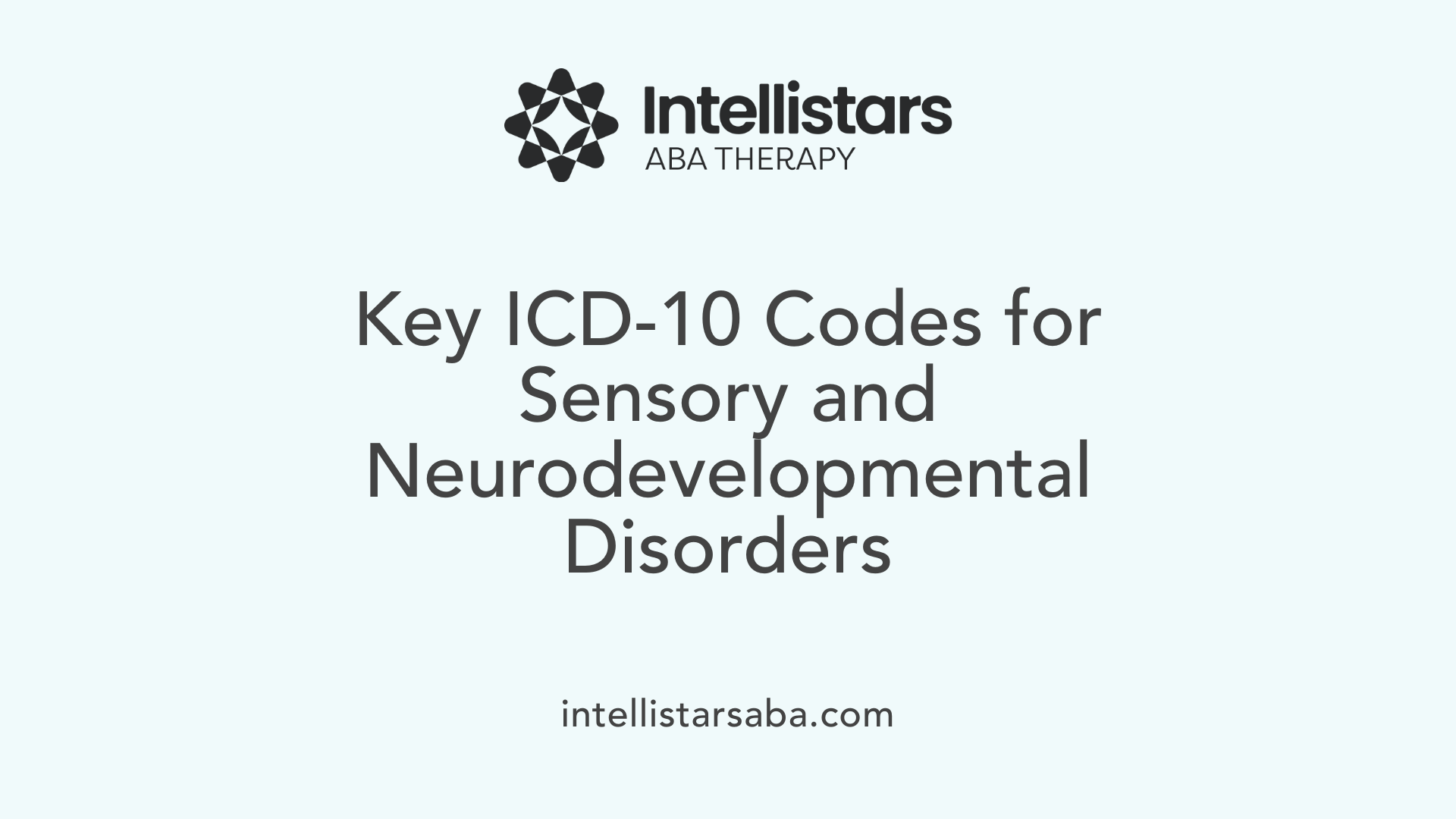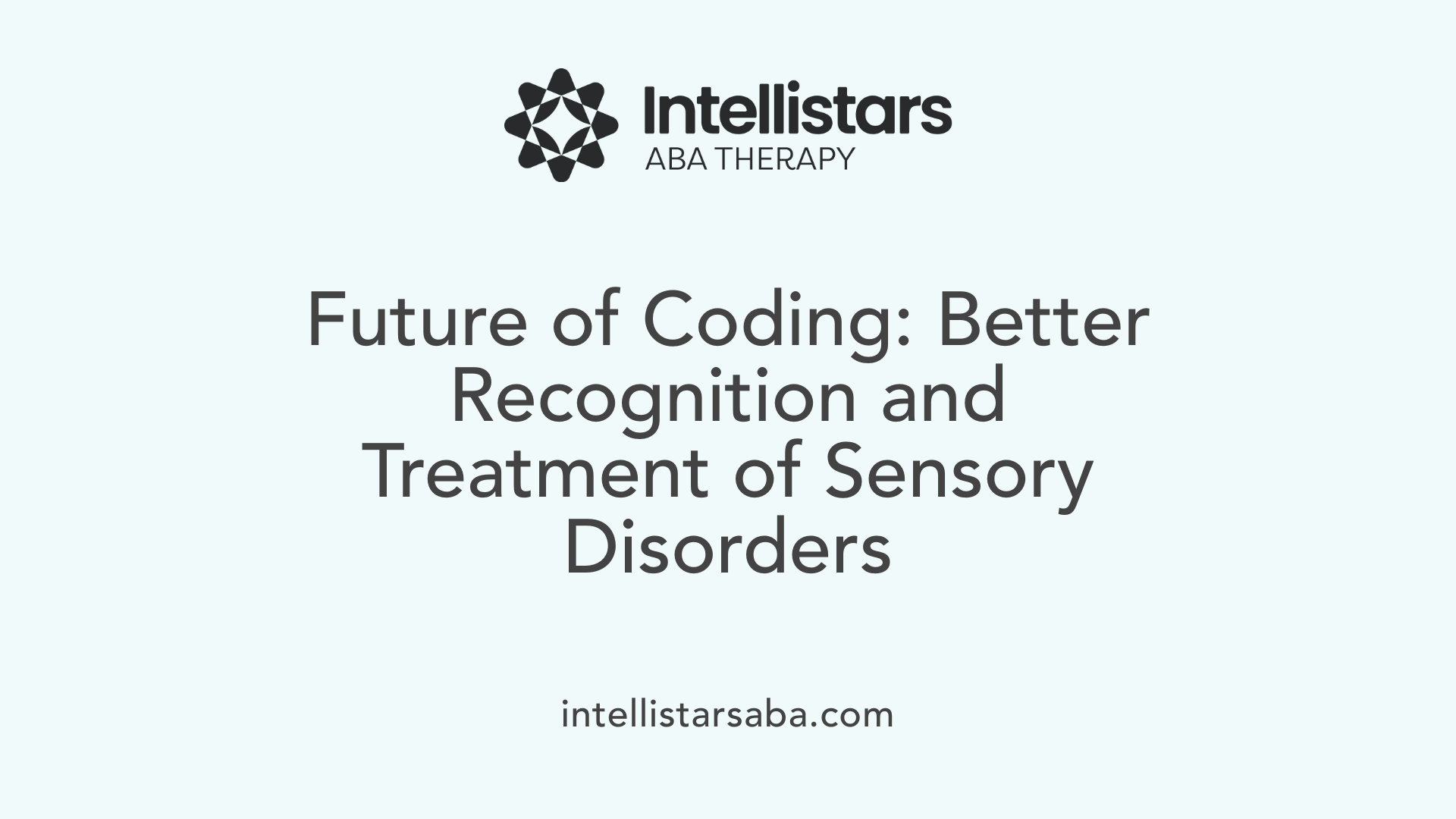Understanding Sensory Processing Disorder and Its Coding
Sensory Processing Disorder (SPD) is a complex neurodevelopmental condition that affects how the brain perceives and responds to sensory stimuli. Despite its prevalence, especially among children with autism spectrum disorder and other developmental conditions, SPD is not yet recognized as a standalone diagnosis within the ICD-10 classification system. This article explores the current ICD-10 codes associated with sensory processing issues, the significance of these codes for diagnosis and billing, and the ongoing evolution of sensory disorder recognition within medical coding frameworks.
What is Sensory Processing Disorder (SPD)?

Definition of SPD
Sensory Processing Disorder (SPD) is a condition where the brain has trouble correctly receiving and interpreting sensory information from the environment. This can make individuals overly sensitive or under-responsive to sights, sounds, textures, tastes, and smells. People with SPD may struggle with everyday tasks because their brains don't process sensory inputs normally.
Symptoms and Characteristics
Individuals with SPD exhibit a variety of behaviors and reactions. Common signs include clumsiness, discomfort with certain textures or clothing, and sensory seeking behaviors like touching everything or making loud noises. They may also have difficulty recognizing personal space or reacting appropriately to sensory stimuli. These symptoms can vary widely from person to person and may affect multiple senses.
Impact on Daily Life
SPD can significantly impact daily functioning. For instance, a child might find it hard to concentrate in a noisy classroom or avoid certain foods because of texture sensitivities. Adults with SPD may experience challenges in social settings or occupational environments. Although SPD is not officially classified as a standalone diagnosis in current medical systems, its effects are real and often require management.
Associated Neurodevelopmental Conditions
SPD is frequently seen alongside neurodevelopmental conditions such as autism spectrum disorder (ASD) or attention deficit hyperactivity disorder (ADHD). While SPD itself is not formally recognized as an exclusive diagnosis in manuals like the DSM-V, it is considered a symptom complex that can be part of other developmental disorders. Many assessment tools like the Sensory Profile and Sensory Processing Measure help clinicians evaluate and address these sensory challenges.
Coding and Diagnosis in Medical Systems
Although there is no specific ICD-10 code solely for SPD, related codes like F84.0 for 'Pervasive Developmental Disorders' and F88 for 'Other disorders of psychological development' are often used by clinicians for diagnosis and billing. The ICD-10-CM code F88, introduced recently, covers 'other disorders of psychological development,' including sensory integration issues. Additionally, symptom-related codes like R44.8 can be used for general sensory symptoms, which are recognized as part of broader diagnostic classifications.
Future Outlook
As awareness of sensory processing issues grows, future revisions of classifications like ICD-11 are expected to include more precise codes for SPD. For now, comprehensive assessment and management strategies like occupational therapy remain vital in improving the quality of life for individuals with sensory processing challenges.
The Dose of Recognition: ICD-10’s Approach to Sensory Processing Issues

Is there an official ICD-10 code for Sensory Processing Disorder?
Currently, there is no specific ICD-10 code exclusively assigned to Sensory Processing Disorder (SPD). Healthcare providers often utilize the code F88, which covers other disorders of psychological development. This classification includes sensory integration issues like SPD, particularly when detailed coding is needed for insurance reimbursement and medical documentation.
In addition, clinicians may choose to use F84.0, designated for Pervasive Developmental Disorders, which encompasses a range of developmental conditions affecting communication, social interaction, and behavior. Since SPD is not formally categorized as a standalone diagnosis in ICD-10, the code F84.9, for unspecified pervasive developmental disorders, is sometimes used when a more specific classification isn’t available.
These codes serve practical purposes, allowing practitioners to document symptoms relevant to SPD effectively. They also support consistent data collection, research efforts, and insurance processes. However, the absence of a dedicated code highlights ongoing challenges in clearly defining and diagnosing sensory processing issues within the current ICD-10 framework.
Looking ahead, revisions such as ICD-11 are expected to enhance the recognition and classification of sensory processing problems. These future updates might introduce more specific coding options, improving diagnosis accuracy and the allocation of healthcare resources for individuals with SPD.
Understanding Recognition within the ICD-10 System

How is Sensory Processing Disorder recognized within the ICD-10 system?
Currently, there is no specific ICD-10 code dedicated solely to Sensory Processing Disorder (SPD). This absence means that healthcare providers must rely on related diagnostic codes to document the condition.
One commonly used code is F84.0, which falls under neurodevelopmental disorders. This code is applied for individuals exhibiting atypical responses to sensory stimuli, capturing aspects of SPD within a broader diagnostic category.
Another relevant code is F84.9, designated for unspecified pervasive developmental disorders. This code encompasses conditions affecting communication, social interaction, and behavior, indirectly including cases where sensory processing issues are prominent.
Additionally, the code F88, classified as 'Other disorders of psychological development,' is often utilized when describing sensory integration problems. F88 is also used for developmental delays and neurodevelopmental abnormalities that may involve sensory processing challenges.
For symptoms directly related to sensation and perception, clinicians can also reference code R44.8, which accounts for
The Significance of ICD-10: From Diagnosis to Billings
What is the significance of ICD-10 coding for diagnosis and medical billing of SPD?
The ICD-10 coding system is essential in standardizing how healthcare providers diagnose and bill for various conditions, including sensory processing disorder (SPD). Although there isn’t a specific ICD-10 code exclusively for SPD, clinicians rely on related codes to document symptoms and related neurodevelopmental issues.
For instance, the code F88, labeled as "Other disorders of psychological development," is often used because it encompasses disorders involving sensory integration challenges. This code helps providers communicate the presence of sensory-related symptoms when submitting insurance claims, which is crucial for reimbursement.
In addition, clinicians may use other codes such as F84.0, which refers to childhood autism, or F84.9 for unspecified pervasive developmental disorders. Codes like R20.3 for hyperesthesia are also utilized to specify particular sensory sensitivities.
Accurate coding with these identifiers supports precise data collection, enabling better research on prevalence and outcomes. It also ensures that insurance companies understand the basis of diagnoses and validate claims accordingly.
Despite ongoing debates about whether SPD should be recognized as a standalone diagnosis in ICD-10, these codes help in the practical aspects of diagnosis, treatment planning, and insurance processing. As ICD-11 evolves, more specific classifications for sensory processing disorders are expected, potentially refining the diagnostic and billing processes.
Additional ICD-10 Codes Related to Sensory and Neurodevelopmental Disorders

What are the other relevant ICD-10 codes related to sensory disorders?
Several ICD-10 codes are used to indicate conditions that involve sensory processing difficulties or are related to neurodevelopmental disorders where sensory issues are prominent.
One such code is R20.3, which pertains to hyperesthesia. This condition involves increased sensitivity to stimuli, such as light, sound, or touch, and is often observed in sensory processing challenges.
Another commonly used code is F88, designated for 'Other disorders of psychological development.' This broad category includes various neurodevelopmental issues, often encompassing aspects of sensory processing and integration disorders. Because SPD does not have its own specific code, F88 helps clinicians document related symptoms.
Furthermore, F84.9 is employed for unspecified pervasive developmental disorders. This code covers conditions affecting communication, social interaction, and behavior—features often seen in autism spectrum disorder and related conditions that can include sensory processing problems.
Additional relevant codes include F84.0, which refers to autistic disorder, F84.2 for Rett's syndrome, and F84.5 associated with Asperger's syndrome. All these conditions can present with sensory sensitivities and processing challenges.
Lastly, the code R44.8, which became effective on October 1, 2024, is for 'Other symptoms and signs involving general sensations and perceptions.' It captures sensory symptoms that do not fit other categories, providing a useful option for documenting sensory issues when no specific diagnosis has been confirmed.
| ICD-10 Code | Description | Typical Conditions/Uses |
|---|---|---|
| R20.3 | Hyperesthesia | Increased sensory sensitivity |
| F88 | Disorders of psychological development | Encompasses SPD-related symptoms |
| F84.0 | Autistic disorder | Autism with sensory components |
| F84.2 | Rett's syndrome | Neurodevelopmental disorder with sensory features |
| F84.5 | Asperger's syndrome | Autism spectrum with sensory sensitivities |
| R44.8 | Other symptoms involving perception | Unspecific sensory symptoms |
Understanding these codes helps clinicians accurately document sensory and developmental issues for diagnosis, insurance, and research purposes. Although SPD itself isn't directly coded in ICD-10, these related codes facilitate its recognition and the tracking of related symptoms.
Implications for Practice and Future Coding Developments

How is the recognition of sensory disorders evolving?
Recognizing sensory disorders like Sensory Processing Disorder (SPD) has historically been challenging due to the absence of a specific ICD code. Currently, clinicians often rely on broader codes such as F88, which encompasses 'other disorders of psychological development,' to include sensory integration issues.
Recent updates in ICD-10-CM and the progression towards ICD-11 reveal a trend toward better acknowledgment of sensory processing challenges. While inhaling specific codes for SPD remains elusive, these developments reflect increasing awareness that sensory issues play a significant role in neurodevelopmental conditions.
What is the future outlook for coding sensory processing challenges?
Future revisions of global classification systems like ICD are expected to enhance the recognition and precise coding of sensory processing challenges. The upcoming ICD-11, for example, aims to improve the classification of neurodevelopmental disorders, potentially including more specific codes for conditions like SPD.
These developments will likely facilitate better diagnosis, targeted treatment, insurance coverage, and epidemiological research. Although SPD remains unclassified as a distinct diagnosis in ICD-10, ongoing recognition of sensory issues within neurodevelopmental frameworks signals progress toward more accurate representation in future coding systems.
How will improvements impact diagnosis, treatment, and research?
More accurate coding directly impacts clinical practice by providing clearer diagnostic options, which can streamline intervention strategies. Better classification also promotes insurance reimbursement, reducing barriers to accessing therapies like occupational therapy.
From a research perspective, advancing coding specificity allows for more precise epidemiological data collection. This informs policy decisions and resource allocation, ultimately improving patient outcomes.
| Aspect | Current Status | Future Developments | Implications |
|---|---|---|---|
| Diagnostic Codes | No specific code for SPD | Possible inclusion in ICD-11 | Better diagnosis and treatment options |
| Recognition | Partial, grouped under broader categories | Increased focus with improved classification | Enhanced clinician awareness |
| Reimbursement | Often reliant on related codes | More specific codes could enhance billing accuracy | Improved funding for therapies |
| Research | Limited specific data for SPD | Refined data collection and prevalence tracking | Better understanding of SPD prevalence |
Understanding these evolutions underscores the importance of staying updated with classification changes. They hold promise for more accurately capturing sensory processing difficulties, ultimately benefiting patients and clinicians alike.
Practical Assessment and Identification of Sensory Challenges
How are sensory processing difficulties assessed?
Occupational therapists often use specialized tools to evaluate sensory processing challenges. Common assessment instruments include the Sensory Processing Measure (SPM), the Sensory Profile (SP), and the Adult/Adolescent Sensory History (AASH). These tools help identify how individuals respond to sensory stimuli across different environments and activities.
The Sensory Profile is widely used to gather information about sensory processing patterns in children and adolescents. It evaluates responses to visual, auditory, tactile, and other sensory inputs, providing insight into sensory sensitivities or avoidances.
The Sensory Processing Measure (SPM) offers a comprehensive view by including ratings from caregivers and educators, making it useful for assessing sensory issues in school settings.
For adult clients, the Adult/Adolescent Sensory History (AASH) can be employed to document sensory sensitivities and their impact on daily life.
What role do occupational therapists play?
Occupational therapists are key professionals in the assessment process. They utilize these tools to diagnose sensory processing issues and to tailor interventions accordingly.
Therapists observe sensory responses directly and interpret assessment results to develop personalized strategies that improve sensory integration and daily functioning.
They also educate families and caregivers about sensory challenges, providing strategies to manage sensitivities at home, school, and work.
Why is accurate documentation important?
Precise documentation of sensory processing difficulties influences both diagnosis and treatment planning. It ensures that health insurance claims are properly supported with specific details about the individual's sensory profile.
Accurate assessments also contribute to research efforts by providing consistent data on prevalence and characteristics of sensory processing issues.
In summary, thorough evaluation using validated tools and expert interpretation by occupational therapists are essential steps in understanding and managing sensory processing challenges effectively.
Looking Forward: Better Recognition and Coding
While current ICD-10 coding practices provide some means to document and address sensory processing issues, the absence of a dedicated code for SPD highlights the need for ongoing recognition and classification improvements. As research advances and awareness grows, future ICD updates are anticipated to include more precise diagnostic codes, facilitating improved diagnosis, treatment, and insurance reimbursement processes. For now, clinicians and researchers continue to rely on related codes like F88 and F84.9 to represent the complex spectrum of sensory processing disorders, advocating for continued evolution in medical coding practices to better serve individuals affected by sensory challenges.
References
- What is the Sensory Processing Disorder ICD-10 Code?
- Sensory processing disorder
- 2025 ICD-10-CM Diagnosis Code R44.8
- What is the Sensory Processing Disorder ICD-10 Code?
- Sensory processing disorder
- What is the Sensory Processing Disorder ICD-10 Code?
- Sensory processing disorder
- What is the Sensory Processing Disorder ICD-10 Code?
- What is the Sensory Processing Disorder ICD-10 Code?






